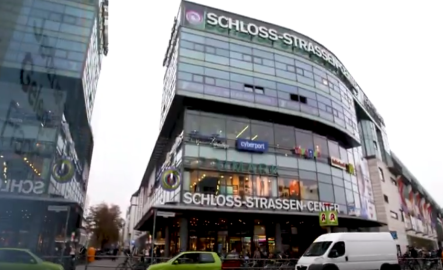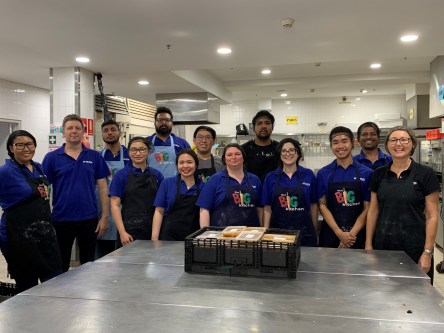Second Closet, a start-up based in Toronto, is revolutionizing the storage industry. The company was created on an operating model where users only pay for what they store, not a fixed storage locker price. With prices starting as low as $3/month, customers can have a virtual second closet to store seasonal, personal and unused items. The company picks up items for storage and delivers them back when clients need them again. With the rising population and demand for space in Toronto, people are struggling to find extra storage. These services are transforming the storage industry and addressing prominent issues of the moving pains associated with city living. This year, Second Closet raised $2 million from investment company MIG Group, helping to fully launch the business and make the entire storage process convenient and efficient.We spoke to founder and CEO, Mark Ang for more details. He cofounded the company with his brother, David. Why is now the time for your company to exist? Ang: There’s going to be 10B people in the world by 2050. They aren’t going to be flooding the suburbs, they’ll gravitate to urban areas provided there’s housing available. At the same time, we’re not seeing condominium developments slow down. For cities like Toronto, it’s easy to look at a city like New York to get a glimpse of what life could and likely will be like when things get more densely populated. Since housing prices outpace personal income, condo developers are simply building smaller units so that they still achieve the optimal price per square foot but the nominal price of the unit as a whole is within financial reach. That basically creates a whole lot of shoe boxes in big urban cities. I think we’re position well to help people...
CA Benchmarking
Yardi Smart Energy Suite is Ready
A California energy benchmarking law going into effect next June requires multifamily property owners to complete a potentially daunting array of information gathering and reporting requirements. Yardi’s energy management software and experts stand ready to make the process easy and painless. Under the mandate, known as AB 802, owners of multifamily buildings with more than 17 units, or gross floor area of 50,000 square feet, must report information on energy use from all energy meters using ENERGY STAR® Portfolio Manager®. Reports to the California Energy Commission for 2018 are due to the California Energy Commission on June 1, 2019, and annually thereafter. Similar requirements for commercial buildings went to effect in June 2018. Actions the commission recommends to meet the June 1 deadline begin by Feb. 1, 2019. Each building’s energy efficiency will be disclosed on a yet-to-be-established state website. “Publicly disclosing the performance of buildings will allow building owners and tenants to make better informed purchasing and leasing decisions, and the general public to better understand the buildings in which they live and work,” according to the California Energy Commission. Yardi is an ENERGY STAR Partner and is helping California users of the Yardi Smart Energy Suite get ready for AB 802. All owners of more than 330 California properties that rely on Yardi for ENERGY STAR benchmarking have retained the company in preparing for AB 802. Yardi Utility Expense Management, an element of the Yardi Pulse Suite, centralizes utility cost and consumption data and sends it directly into ENERGY STAR Portfolio Manager. Portfolio Manager is an online tool for tracking energy and water consumption and greenhouse gas emissions. It also allows comparisons of a building’s energy performance against similar-type buildings. Elements of AB 802 compliance include setting up multiple measurement criteria for...
On the Go Giving
Move for Hunger
Looking for a way to get more involved with the local community? Move for Hunger is a nonprofit that connects you, your residents, and your local food bank. Move for Hunger partners with the American Moving and Storage Association to get nonperishable food into the hands of those in need. Before relocating, residents coordinate with their moving company to deliver unwanted goods to local food banks. To date, the organization has transported more than 11,479, 245 pounds of food to food banks. The donations created 9,566,038 meals for people facing food insecurity. You and your residents can get in on the giving! Arranging a Move for Hunger Donation Setting up a Move for Hunger donation is incredibly simple. First, residents must find a participating professional mover. There are more than 1,000 to choose from across the United States. (And since residents are relocating, anyway, this step is super practical.) The residents and the mover will set up their moving date. While the residents are packing their belongings, they set aside the nonperishable items that they’d like to donate. On the day of the move, the mover will transport the nonperishable food to the nearest local food bank. Benefits for Residents Residents are looking for a way to quickly and easily clean out their unit. Move for Hunger helps them do just that. • All the food that they can’t eat before the move is relocated, rather than tossed in the trash. Donating the unwanted food requires no additional legwork for residents. • The food pick-up may potentially minimize the cost of the move! By donating items in the fridge, pantry, and cabinets there will be fewer boxes to move while residents are being charged. Benefits for You! By promoting Move for Hunger, you’re doing...
Accounting Simplified...
Yardi Voyager Residential
Yardi Voyager Residential consolidates property management and financial accounting into a single platform. The fully-integrated suite of multifamily and marketing products makes it easier to manage the entire real estate cycle. Is Voyager Residential Right for My Organization? That depends on several factors. Are you a large organization looking for scalable solutions? Voyager grows and diversifies with you. Users gain access to real-time performance analytics across their entire portfolio, regardless of size. Organizations with smaller portfolios, such as family holdings, may benefit from Yardi Breeze. Do you seek a compliant, accurate and efficient way to manage your portfolio? Voyager financial management features meet all applicable accounting standards and regulatory requirements. Property management features streamline workflows for leasing, move-ins, move-outs, work orders, purchase orders, and everything in between. Would you prefer to leave software management to the tech pros while you run your business? Yardi’s award-winning cloud services manage data storage and updates on your behalf. You can focus on growing your business while Yardi handles the minutia of the software. Does a comprehensive suite of software seem more appealing than a piecemeal combination of products? Yardi Voyager Residential integrates with the Yardi Multifamily and Marketing Suites as well as Yardi Elevate. You benefit from a unified entity for marketing, customer relationship management, procurement, facilities management, energy management, and business intelligence. Do you value flexibility? With Voyager, you aren’t stuck to your desk. Voyager comes mobile-ready and browser agnostic, keeping your team members connected whether they are in the office or in the field. Raising the Bar Yardi is an established company with a proven track record. For more than 30 years, Yardi has supported client success with quality real estate management solutions. Though established, Yardi continues to evolve. Ongoing improvements ensure that client feedback...
Food Bank CENC
Helping Hurricane Victims
In September 2018, Hurricane Florence left disaster in its wake. Low-lying towns along the South Carolina and North Carolina coasts received the worst of the damages. In the months to come, the storm would unite the region in one of its darkest hours. Hurricane Florence dumped 30-36 inches of rain on the region in two days. The rainfall caused catastrophic flooding. Cape Fear River, which runs nearly 200 miles from the Atlantic to Wilsonville, crested 62 feet. Nearby rivers and creeks also flooded, submerging homes, destroying businesses and washing out two interstates. About 350, 000 people were without power in North Carolina. At least 43 people lost their lives in storm-related events. Following the bleak aftermath came a surge of hope. Assistance poured in from throughout the nation, with the strongest concentration of aid coming from neighboring states. Food, clothing, and supplies began to make their way to those in need. On the ground, Food Bank of Central & Eastern North Carolina (FBCENC) and its 100 partner agencies were among the first to channel the aid and help communities recover. Volunteer Services Coordinator Michael McKay said, “You see an outpouring of love at this time, during a disaster. It’s amazing that we see so many people here to help out.” FBCENC set up more than 85 contact points in the hardest hit areas. “We’re going to be here for you,” said Michael Cotten, Branch Director at FBCENC. “The Food Bank is a first responder and we’re going to be here in the long term.” Yardi corporate contributed funds to FBCENC to support relief programs. “While the efforts are far from over, we have been able to provide more than 5.5 million pounds of food and supplies to our neighbors over the past two months...
Increase Conversions
Master the Landing Page
If your pay-per-click (PPC) campaign leads prospects to your home page, you’re missing out on conversions. Creating a landing page for your paid ads is a proven way to increase your conversion rate. What is a landing page? A landing page is not built into your website through the navigation menu. It is a stand-alone page that prospects land on after clicking your paid ad. The sole purpose of a landing page is to get your prospects to take action. The landing page should provide a quick summary of what you have to offer. It should then direct the prospect on how to take advantage of the offer (the conversion). That’s it. Why are landing pages so powerful? Organizations that use landing pages experience more conversions. Research reveals that more landing pages lead to more conversions. Paid ads placed in internet searches, emails, or social media campaigns should guide prospects to a landing page. In fact, landing pages help ads achieve a greater return on investment. They also improve your site’s quality score. Without a landing page, your cost per lead rises and your conversion rate lowers. You’ll pay more for less business! What should my landing page include? Keep your landing page informative yet simple. Landing page essentials include: Your logo Quickly reestablish your brand with by placing your logo near the top of the landing page. A captivating headline A solid headline does two things. First, it confirms that prospects have arrived to the correct page after clicking your ad. You can achieve this by using the same language in the headline as you did in the ad. Secondly, the headline entices the prospects to read more and take action. Copy and media that mimics the language of the ad Your copy...
Market Sharing
Students + Sharing Economy
They say that sharing is caring. Turns out, sharing is also a great selling point for your student housing community. By integrating the share culture into your student property, you can reap the benefits of this growing economic sector. The sharing economy flourishes worldwide. Its convenience and innovation has won over millions of users. According to PWC research, 83 percent of respondents say the sharing economy is more convenient and efficient than conventional methods of shopping, transportation, and completing tasks. Share practices are already active in your student housing community. Why not capitalize on their success? No- and Low-Cost Solutions You don’t have to spend a lot of money to bring collaborative consumption to your student property. These low-cost solutions are a great place to start: By 2025, the rideshare economy will have an estimated cumulative worth of over $335 billion. Show that you are adapting to the times. Designate an area in your community for rideshare pick-up and drop-off. Mark this area with signage using the rideshare service provider logos, such as Lyft and Uber. If your property has a security gate, place the designated area outside of the gate. This results in fewer guests with gate access codes and shorter lines at the callbox. Make rideshare services easy to access from your property website. True, most users will hail a ride using their smartphone app. The link on your property site, however, shows prospects and residents that you are responsive to their needs and interests. Market the desirability of your location by highlighting food delivery services available in your community. Doordash, Uber Eats, and GrubHub delivery services are popular with young adults. A community share forum creates a sense of cohesion and support within your student housing property. The forum can serve as...
Originations Wane
Market Analysis
Editor’s note: Paul Fiorilla is director of research for Yardi Matrix. His analysis of waning loan originations, despite high demand for apartments and industrial real estate, was recently published by Globe Street. You can find the full report summary available for download here. (Select the national category.) Concerns about rising interest rates and weakening economic growth have led to a slowdown in commercial mortgage originations, particularly in out-of-favor asset types, despite the wide availability of debt capital. The Mortgage Bankers Association reported that commercial mortgage originations in 3Q18 fell 7 percent from the same quarter a year ago. The biggest drop came from CMBS, which fell 53 percent year-over-year, and commercial banks, which originated 22 percent less than a year ago, according to the MBA’s survey. Life companies and the GSE multifamily lenders posted slight increases in lending. The decline in lending is more a reflection of demand than supply. No major source of debt capital is pulling back, and the number of debt opportunity funds is on the rise. However, property sales have dipped about 10 percent nationally, while rising interest rates are discouraging some borrowers from refinancing. Since bottoming at just over 2.0 percent in September 2017, the 10-year Treasury has increased steadily and has been over 3.0 percent since mid-September. That has increased loan coupons, although loan spreads have generally come down 40 to 50 basis points over the past year, so the cost of borrowing has not risen as much as interest rates. Tightening loan spreads reflect the healthy appetite among lenders to book loans. Another headwind to originations is the decline in property sales as buyers start to pull back. Sellers are getting fewer bids and – while acquisition yields aren’t yet climbing appreciably – buyers are seeking to...
Empowering Learners
Yardi + EqualiTech
The second annual Santa Barbara Gives! (SB Gives!) is now underway. This holiday fundraiser and competition is a fun way to unite local donors and nonprofits. When their efforts are combined, Santa Barbara thrives. So, What’s This All About? SB Gives! aims to motivate philanthropy by highlighting innovative nonprofits. Readers can explore the nonprofits’ missions on the SB Gives! website. Once inspired, readers are encouraged to donate to their nonprofit(s) of choice. Of course, a little friendly competition keeps things interesting. SB Gives! features a leaderboard to show which nonprofit has raised the most funds to date. Donations are tracked in real time! What’s the Skinny on EqualiTech? Among the noteworthy nonprofits stands EqualiTech, the brain child of math teacher Danny Fitzgibbons. Through his studies and career, he learned of the disparity that occurs between children with early access to technology and those without. Learning gaps are evident as early as kindergarten. Fitzgibbons wanted to create a program that provided access to critical technologies regardless of socioeconomic status. Today, EqualiTech makes technology accessible to residents of Goleta and nearby neighborhoods. The organization aims to improve computer literacy by providing public computer access at Goleta Valley Tech Center. The site is staffed by a bilingual manager and instructor who is available to answer questions and work one on one with patrons who need help. At the center, students learn basic computer skills such as typing, navigating a computer, and creating and managing an email account. Students can also receive help with special projects like website design and resolving hardware issues. Students’ time at EqualiTech is meant to be fun and practical. Naturally, students learn how to keep in touch with loved ones via social media. Of equal importance, they learn tips and tricks on how to...
Coworking Revolution
Becoming mainstream in UK
Increasingly, companies don’t have a five-or 10-year vision based around a particular space with a particular staff mix. They want short-term arrangements where they can flex their head count and floorspace up or down depending on need. This applies to businesses both large and small. While coworking once meant an office for four to six people, today deals are being signed for spaces that will accommodate 25, 50 or even 100 staff. Coworking also helps firms to retain the best employees by providing them with a stimulating and collaborative working environment. Sitting behind all of this is new technology which means that operating or using a coworking space is more streamlined than ever before. But with so many coworking spaces springing up, competition is getting ever more intense. So what can operators do to make their schemes are a success? Businesses today are looking for more than just a desk, a telephone and an internet connection – they want a level of service on a par with what you would expect in a high-end hotel. Years ago, we used to call the people sitting in the entrance ‘receptionists’, but today we refer to them as ‘front-of-house.’ In a successful coworking space they should engage with members, know them by name and be on hand to manage all aspects of the customer experience. Technology is a big part of this. A fast, reliable internet connection is crucial to most businesses and Yardi’s software means access to spaces is seamless, so when a member enters a coworking space they are instantly recognised and connected to the wifi. This can even work across multiple coworking locations. Unlike more traditional companies where most staff leave the building between 5pm and 6pm, some companies operating out of coworking spaces...
Industrial Strength
Matrix Market Report
Yardi Matrix took a close look at the U.S. industrial real estate market’s performance in the first half of 2018 and found plenty of positive signs. Indications of the sector’s strength include: Strong demand for space driven by year-over-year e-commerce sales growth of 15.4% Nearly 125 million square feet of industrial space coming online 7% year-over-year rent growth A national vacancy rate below 5% in the first quarter, the lowest since 2010 Commercial real estate-leading investment volume “Demand is stronger than ever” in every industrial subsector, the report says, with warehousing, manufacturing and flex space accounting for most of the occupancy gains. Demand was strongest in California’s Inland Empire, followed by Chicago and New Jersey. The industrial sector continued to benefit from rising e-commerce sales, which totaled $120.4 billion in the second quarter alone and drove the need for distribution centers near dense population areas. Over 90% of the first half’s new supply was warehouse and distribution space, with more than 238 million square feet of additional space under construction at mid-year. In markets where available land for development is scarce, developers focused on renovation and site remediation projects, expecting to recover costs with higher rents. Industrial rents continued to increase in most markets, spurred by the exceptional demand and lack of excess space in the top logistics markets. Rents averaged $6.29 per square foot at mid-year, up 7% year-over-year. “Expect rents to further increase through 2018 as the quality of available inventory improves due to upgrades and addition of new space,” the report says, noting that a slight deceleration might follow in 2019 as projects now under construction add to available inventory. The national industrial vacancy rate, 4.9% in the first quarter, was largely due to companies snapping up space before it was...
5 Easy Tips
For Better Property Photos
Commercial property photos are notoriously unimaginative. Prospects have grown accustomed to mundane shots of empty spaces. But what if you offered something more interesting? Your property will gain the competitive advantage. Below are five tips for better commercial property photography that will help you stand apart from the crowd. Show Interactions, Not Spaces All commercial spaces have a ceiling, walls, and a floor. Skip the boring space photos. Instead, showcase interactions and operations within the space. Here are a few examples: Accentuate the room’s natural light by depicting an employee as she waters thriving, indoor plants near large windows Capture a team effortlessly unloading packages on the spacious and updated loading dock Emphasize your rapid WiFi availability with teams working simultaneously on their laptops and mobile devices Highlight your services by showing a vendor removing a recycling bin from the site Stage Like Sales Depend on It! As you’ve gathered by now, staging a commercial space may require models and supplies. It could be worthwhile to invest in office furniture so that you can stage spaces now and in the future. Otherwise, you can find models, photographers, and props on sites like MuseCube, Model Mayhem, and OneSource Talent. Commercial tenants want to see the potential of the space that you offer. If live staging is cost prohibitive, consider virtual staging. Virtual “renovations” are a great way to show potential uses for the space. Showcase Versatility Think beyond expected uses of the unit. Consider creative approaches for the space, such as coworking and CrossFit. By thinking outside of the box, you may attract a prospect that had not previously considered your site. Location, Location, Location Your property’s neighborhood may be a noteworthy part of your marketing efforts. Are there restaurants nearby that tenants may enjoy...
Supporting the Community
Yardi Atlanta
To jumpstart the giving season, Yardi Atlanta Charity Committee recently released an overview of the year’s philanthropic efforts. The grants demonstrate Yardi’s mission to “take care of our communities” in action! The following 15 nonprofits received support from Yardi Atlanta in 2018. March of Dimes March of Dimes programs educate medical professionals to ensure that moms and babies get the best care available. The organization also helps families with newborns who are facing medical challenges. Several Yardi Atlanta team members participated in the annual March for Babies walk, hosted by March of Dimes. Yardi corporate also matched donations made to the organization. Mimosa Elementary School Mimosa Elementary is a Title 1 school of about 800 students. Located within an Economic Opportunity Zone, nearly 95 percent of parents’ incomes fall below the poverty line. Despite its difficulties, the dedicated school staff and Yardi team members work together to help students succeed. Recent initiatives included a backpack drive and courtyard cleanup. This year’s donation focused on improving the reading levels of third graders. Studies suggest that third grade literacy increases high school graduation rates. Camp Twin Lakes Camp Twin Lakes is a nonprofit with locations in Rutledge, Winder, and Warm Springs, GA. Camp excursions and activities provide fun developmental opportunities for children facing serious illnesses and disabilities. Kids can also experience the fun through the Campers to Go program, which takes interactive experiences to children’s hospitals throughout the state. Camp Twin Lakes continues its strong relationship with Yardi Atlanta. Through the Camper Scholarship Program, Yardi empowered 27 kids to attend camp. Make-A-Wish Georgia Never underestimate the power of a dream fulfilled! The national Make-A-Wish Foundation grants wishes for children facing life-threatening illnesses. Granting a wish brings hope! And a positive attitude can help to battle illness and improve quality of life. Yardi’s donation enabled 406 critically ill children to watch their dreams come true. Atlanta Humane Society The Atlanta Humane Society, a no-kill shelter, serves about 30,000 animals each year. Animals receive medical assistance as well as the opportunity to find a forever home with local families. Yardi’s contribution paid for 5,000 surgeries for rescued animals. Atlanta Community Food Bank In northwest Georgia, 1 in 5 children face food insecurity. Atlanta Community Food Bank aims to end food insecurity for families in need. Yardi’s donation supported mobile units that meet immediate demand for nutritious food in homes and at schools. While on site, staff members help residents complete screenings for longer-term assistance programs. Marcus and Sharon Gunter Foundation (MSG Foundation) Hunger adversely affects health outcomes as well as a person’s quality of life. The MSG Foundation serves families, children and seniors facing hunger in Cumming, Ga. With Yardi’s support, recipients receive aid through a monthly grocery supplementation program. School-aged children are eligible for Bags of Love, which provides sack lunches to kids during school breaks. Atlanta Children’s Shelter Atlanta Children’s Shelter aims to end family homelessness in Georgia. The organization also offers therapeutic programming to facilitate recovery from trauma. Yardi Atlanta’s donation was allotted to the STEAM program, which helps homeless children reach developmental and academic milestones. Foster Care Support Foundation More than 8,000 children rely on foster services in Georgia. Children can escape abuse and neglect through Foster Care Support Foundation. The organization supplies essential items for foster parents and their families. Yardi’s donation provided 90 children with necessities such as clothing, books and basic care items. The contribution minimizes financial strain for foster families. Yardi’s donation also supports the mentorship program that helps teens in foster care navigate their journey towards adulthood. Lost-n-Found Sexual minority youth compose more than 40 percent of homeless youth in Atlanta. Lost-n-Found Youth strives to end homelessness for young members of the LGBTQ community. The nonprofit offers housing and counseling services to those in need. In addition to financial donations such as Yardi’s, Lost-n-Found Youth provides services through thrift shop revenues. The Drake House...
Meeting Challenges
Germany's Kintyre
Frankfurt, Germany-based Kintyre is a full-service real estate manager for investors in the German real estate market, offering property management, bookkeeping, leasing and tenant relations, and strategic asset management, among other services. Kintyre manages a Germany-wide portfolio valued at over €1.4 billion, totalling 800,000 square metres. The retail subsector accounts for three quarter of its assets under management, with office comprising most of the remainder. “We pride ourselves on having a team of experienced local property professionals, who have the ability to understand and deliver on our international investor’s expectations and requirements. We add value for our clients and partners through providing a fully integrated service platform, including all elements of the regular real estate management services, plus the addition of strategic retail concepts and design coordination, a strong leasing team, project management, and acquisitions and sales coordination,” says Adam Pearce, Kintyre’s managing partner. With investment returns within the German real estate market remaining under ongoing pressure, due to the current peak pricing environment, the increased use of technology is one additional tool professional real estate managers are adopting to help ensure maximum efficiency within the management process, flowing through to a value add for investors. Determined to be at the forefront of the digital revolution facing the global real estate sector, Kintyre upgraded its real estate management and accounting platform to Yardi Voyager. The decision to adopt Yardi Voyager was influenced by Kintyre’s requirements to have a single software solution that was able to operate across multiple jurisdictions and functions. “Being able to meet client standards and regulatory needs in any jurisdiction added a huge amount of confidence in the services we provide. Yardi’s innovation is global in scope but the company also knows the needs of local markets. Having such a multi-dimensional...
Meals for Kids
Yardi Raleigh + Backpack Buddies
Each day, millions of kids rely on the National Breakfast and Lunch Programs. More than 11.6 million free breakfasts and 20 million free lunches help students reach their potential on school days. Such meal assistance is not available to kids in need on weekends. That’s when the Inter-faith Food Shuttle lends a helping hand. Transforming “Waste” Into Meals Inter-faith Food Shutter is an innovative nonprofit based in Raleigh, N.C. The organization disrupts the standard American food cycle, which is rife with waste. More than 40 percent of food that is grown and processed never makes it to families’ tables. Up to 75 percent of produce, for example, is sent to the trash simply because of its appearance. Rather than throwing away more 6 million pounds of local food, Inter-faith Foo d Shutter reroutes the groceries to homes in need. Food is procured from 350 donors including retail donations, volunteer food drives, commercial field gleaning, and the nonprofit’s teaching farm. Yardi Raleigh Preps Meals for Kids Backpack Buddies, an Inter-faith Food Shuttle program, uses rescued food to feed Raleigh’s youth. The program provides 10-12 pounds of food to children from low-income households. The nutritious food is intended to help children through the weekends when free school meals are not available. Each Backpack Buddies bag includes enough food for six meals and two snacks: two proteins, two vegetables, one fruit, two packs of noodles, two milks, one 100% fruit juice and two snacks. Local volunteers help to stuff the backpacks for delivery. Yardi Raleigh rose to the challenge. The Help Desk community service crew turned their team outing into a volunteer opportunity. Volunteers included Ashley Godshalk, Brian Baker, Doug Thompson, Elliott Arnold, Kelly Haygarth, Michelle Gardner, Nick Gennaro, Rashida Lassiter, Utica Cason and Yolanda Eaton. “Team work...
Pets & Service Animals
Management Tips
Permitting animals on your property can help residents feel comforted, capable, and safe. Managing the quantity and purpose of those animals—pets and working animals–has become a hot topic in property management. These four tips may help to standardize and simplify animal management at your site. Understanding the Laws To best accommodate residents with disabilities and their working animals, achieve a basic understanding of the laws that are in place: The Fair Housing Act (FHA) and Section 504 of the Rehabilitation Act of 1973 (Section 504) require housing providers to make reasonable accommodations for people with disabilities. The Americans with Disabilities Act (ADA) promotes accessibility in public spaces. Together, the three laws promote inclusion and safety for those living with disabilities. Both FHA and Section 504 use the term “assistance animal” to describe working animals that provide aid for humans. The ADA refers to “service animals” with the same purpose. The three laws require that housing providers and the managers of public spaces welcome working animals and their owners. Other details of the laws that are worth noting include: -It doesn’t matter if a resident refers to an “assistance animal” or a “service animal.” FHA and Section 504 apply to all animals that assist or perform tasks for the wellbeing of a resident with disabilities. -The laws do not limit the number of assistance animals or service animals a person may have. It is lawful for a person to have multiple pets, each to address a different therapeutic function. -None of the laws require a specific certification or training for the working animal. Required Documentation Establish a documentation policy that’s fair for all prospects with service animals. Implement the policy for apparent and invisible disabilities. The prospect may be asked to provide documentation regarding their need for a service animal or assistance animal. HUD entitles leasing staff to request documentation from a reputable third party who is familiar with the applicant’s condition. Applying Designations for Pets and Working Animals When documenting the animals within a unit, it may be helpful to differentiate between working animals and pets. Residents with service animals or assistance animals may require different accommodations than traditional pet owners. For example, some communities have a limit on the number of pets within a home. A resident with disabilities reserves the right to have multiple animals that assist in different ways. May this resident also have a pet (non-working animal)? Establish a policy and apply it consistently. Helpful Software Business management software may help organize residents and their animal companions. Yardi client Bridge Property Management has customized the set-up of Orion Business Intelligence to keep track of animals on the premises. Yardi product specialist Colin Roberson explains, “We have been able to track how many dogs are on each property, which units have pets. [Orion BI] is a nice thing that the property managers can have on their phone. If they are walking the property and seeing a pet in a unit, they can very quickly verify to see if we have a pet on record there.” “It’s such a practical application,” Roberson continues. “I don’t know if others use it that way but I would say we use it in different ways to track things like that and improve...
Single Family Homes
Managed by Yardi Voyager
Yardi Voyager Single Family Homes simplifies property management without the need to expand payroll. Its property management, accounting and maintenance features are tailored to each clients’ needs. Manage Wisely Get a quick overview of operations each time that you open the Voyager Single Family Homes dashboard. Skim the latest updates on occupancy and availability, resident charges, receipts, property traffic and maintenance. Drill down into details as needed. Leverage the power of the industry’s most widely adopted accounting system. Generate and export custom reports to paint a clear picture of your financial standing. As your company continues to grow, you maintain control over access to that data. Set up users with read-only access to specified features and reports. Regularly issue reports to individual investors with a convenient report scheduler. Paperless cloud storage facilitates access to data from any location on any mobile device. Streamline financial management with Voyager Single Family Homes. The comprehensive systems meets IFRS and GAAP requirements. Expand Effortlessly Voyager Single Family Homes is more than accounting. The system empowers you to automate resident and home management from guest card to move-out. Store property brochures and quote sheets within the system. When multiple parties are interested in your properties, you can create a waitlist by market. As prospects turn into residents, automatically populate the resident records from the data on their guest card. Ensure that your units are in optimal condition with maintenance and work order tracking. Voyager Single Family Homes seamlessly integrates with other Yardi solutions that help your business operate smoothly. Tools for maintenance and inspections, marketing and leasing, procurement, energy management, resident screening and renters insurance unite under the Voyager umbrella. RentCafe Single Family Homes and RentCafe CRM Single Family Homes incorporates marketing, mobile leasing and customer relationship management and...
Our Big Kitchen
Yardi APAC Volunteers
Earlier this month, Team Yardi Australia headed to Bondi in Sydney. Switching out their laptops and phones for kitchen knives and potato peelers, the team spent the afternoons volunteering at Our Big Kitchen (OBK). OBK is about more than food, it’s a community kitchen with a soul. Created in 2000, its designed to help those in need; whether they’re going through a hard time, need a hand getting started, or are just looking for a place that provides a warm and nurturing environment. It aims not just to provide a community to its volunteers, but to help look after the millions of Australians going hungry every day. Despite being “the lucky country,” 2.2 million people in Australia go without food every year. Of those, tens of thousands come from New South Wales. OBK is on a mission to help those people, working closely with organisations such as SecondBite and Foodbank to minimize food waste and turn fresh produce into a home cooked meal. These meals are then distributed to the homeless and to regional shelters, including refuges for women and children, domestic violence shelters, asylum seekers, and more. Last year, OBK distributed over 80,000 meals to those in need. “The experience gave all the people involved a sense of reality of how good a lot of us have it in life. Giving a little bit of our time helped 200 people that day. I recommend everyone gives a little to people in need, just like we did. It was a truly uplifting experience,” said Brook Baker, regional director, Australia and New Zealand sales. For the Yardi team, the afternoons represented an opportunity to give back, whilst learning more about the darker side of the city they live in. George Karounis, founder of OBK, shared...
Let’s Save the World...
Energy Reimagined Before 2050
The recently released UN Intergovernmental Panel on Climate Change report shocked everyone who was paying attention. In short, attempting to mitigate temperature rises to 1.5 percent by 2050 (which already seemed impossible to most) is too little too late. The globe is on a trajectory to see temperatures rise more than 3 percent by that time. The resulting flooding, droughts and superstorms will be catastrophic. A drastic shift in energy sourcing and usage is necessary to limit economic and humanitarian costs. Fortunately, drastic doesn’t mean impossible. Microgrids and carbon dioxide recycling are two available solutions that can make substantial impact. Microgrids Microgrids enable centralized power generation, storage and delivery. They offer more efficient power transmission, reduce costs for consumers, and decrease the duration of blackouts which can save lives and protect economies. A microgrid can “cut air pollution from the electric utility sector as much as 30 percent by 2030, saving 34,000 deaths a year,” states Smart Energy Consumer Collaborative. The systems offer more immediate benefits as well. Hurricanes Florence and Michael, for example, resulted in nearly $100 billion in property damages. After factoring in electricity outages and stalled commerce, Accenture estimates that such storms can cost economies $150 billion per year. The implementation of microgrids would reduce the economic impact of natural disasters by quickly restoring power. Microgrids also facilitate the integration of renewable energy sources with flexible scalability. Local organizations do not need to wait on utility companies or governments to implement more sustainable practices. Solar panels, roof-mounted wind turbines, and other sustainable energy devices can be used as the primary energy source on individual projects. Several power companies are exploring the power, efficiency and reliability of microgrids. Edison International, Central Hudson Gas & Electric, Duke Energy, San Diego Gas & Electric are just...
Powered by Bacteria
Photovoltaic innovation
The energy industry is reinventing itself in combined efforts to limit as much as possible the effects of climate change. Evermore photovoltaic farms emerge around the world, evermore wind projects spring up onshore, offshore near shore, and even air borne—the industry is still in perfecting mode, new ideas turning into new ways to harvest green energy. There’s one more breakthrough in the solar energy world, coming from the scientists at the University of British Columbia. The Canadian researchers managed to develop a bacteria-powered solar cell that can convert light to energy, regardless of the weather, working as efficiently in dim and bright light, which could be a step forward in places like British Columbia and parts of northern Europe where overcast skies are common. Called biogenic cells, these solar cells made of living organism, are intriguing. This new cell generated a current stronger than any previously recorded from such a device. This is the first time when researchers connected nine biological-solar (bio-solar) cells into a bio-solar panel, in an attempt to replicate photosynthesis—the natural way to convert light energy into chemical energy that is later released to fuel the organism’s activities. Previous endeavors were centered around extracting light-sensitive dye from genetically modified bacteria, but the process proved to be quite costly, complex and also not quite safe as during the extraction process, the dye was often damaged by the solvents used. The Canadian team tried something different—they used E.coli genetically engineered to produce ample amounts of lycopene—the molecule that gives tomatoes their orange-red tint. Now, some of you might startle at the sight of E.coli, but this bacteria was chosen for cloning due to its low mutation and recombination rates. Lycopene is considered an excellent natural dye and is fantastic at harvesting sunlight. Their...




















